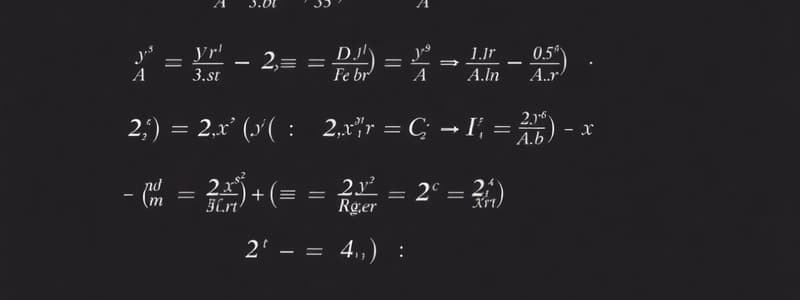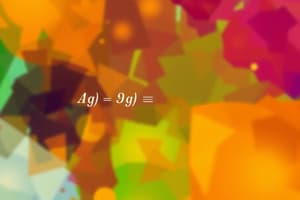Podcast
Questions and Answers
What action should be performed after positioning a patient and applying a tourniquet?
What action should be performed after positioning a patient and applying a tourniquet?
- Administer medication
- Collect the sample
- Ask the patient to make a fist (correct)
- Release the tourniquet
Which of the following is the first step in preparing for venipuncture?
Which of the following is the first step in preparing for venipuncture?
- Clean and air-dry the site
- Apply a bandage
- Prepare the equipment (correct)
- Collect the tubes
Why is it important to allow the site to air dry after cleaning?
Why is it important to allow the site to air dry after cleaning?
- To prevent infection
- To ensure proper needle insertion
- To avoid hemolysis
- Both A and D (correct)
- To ensure that the alcohol does not interfere with the test results
Which action comes directly after selecting the vein?
Which action comes directly after selecting the vein?
What is the first thing you should do when beginning the blood draw process with a patient?
What is the first thing you should do when beginning the blood draw process with a patient?
When should you ask the patient to remake a fist during venipuncture?
When should you ask the patient to remake a fist during venipuncture?
During venipuncture, what does 'anchoring' the vein refer to?
During venipuncture, what does 'anchoring' the vein refer to?
Why is it important to inspect the needle before venipuncture?
Why is it important to inspect the needle before venipuncture?
What are you verifying when asking about diet restrictions?
What are you verifying when asking about diet restrictions?
What safety precaution is verified during the 'verify latex sensitivity' step?
What safety precaution is verified during the 'verify latex sensitivity' step?
After cleansing the venipuncture site, what action should you take?
After cleansing the venipuncture site, what action should you take?
Which of the following is MOST important to have before starting?
Which of the following is MOST important to have before starting?
What is the initial action immediately before putting on gloves?
What is the initial action immediately before putting on gloves?
During a blood draw, what piece of equipment restricts blood flow causing the veins to swell?
During a blood draw, what piece of equipment restricts blood flow causing the veins to swell?
When should you recap a needle?
When should you recap a needle?
Flashcards
Review the test request
Review the test request
Confirm the specific tests needed for accurate diagnosis/treatment.
Approach, Identify, and Prepare patient
Approach, Identify, and Prepare patient
Introduce yourself, verify patient identity and their understanding of the procedure.
Verify Diet Restrictions & Latex Sensitivity
Verify Diet Restrictions & Latex Sensitivity
Confirm any dietary restrictions, allergies to latex or other relevant sensitivities.
Wash hands and put on clean gloves
Wash hands and put on clean gloves
Signup and view all the flashcards
Position patient, apply tourniquet, and ask patient to make a fist
Position patient, apply tourniquet, and ask patient to make a fist
Signup and view all the flashcards
Select vein, release tourniquet, and ask patient to open fist
Select vein, release tourniquet, and ask patient to open fist
Signup and view all the flashcards
Prepare Equipment
Prepare Equipment
Signup and view all the flashcards
Reapply Tourniquet, uncap and inspect needle
Reapply Tourniquet, uncap and inspect needle
Signup and view all the flashcards
Clean and Air-dry site
Clean and Air-dry site
Signup and view all the flashcards
Ask patient to remake a fist, Anchor vein, and insert needle
Ask patient to remake a fist, Anchor vein, and insert needle
Signup and view all the flashcards
Study Notes
Vector-Valued Functions of a Real Variable
- A vector-valued function $\overrightarrow{r}$ links a subset of real numbers to a set of vectors, expressed as $\overrightarrow{r}(t)=(f_{1}(t), f_{2}(t), \ldots, f_{n}(t))$.
- $f_{i}(t)$ are real-valued component functions of the real variable $t$.
Vector-Valued Function Representation
- A vector-valued function of a real variable $\overrightarrow{r}(t)$ can be written as $\overrightarrow{r}(t)=f_{1}(t) \overrightarrow{\mathbf{i}}+f_{2}(t) \overrightarrow{\mathbf{j}}+f_{3}(t) \overrightarrow{\mathbf{k}}$.
- $f_{1}(t)$, $f_{2}(t)$, and $f_{3}(t)$ are the component functions of $\overrightarrow{r}$.
- $\overrightarrow{\mathbf{i}}=(1,0,0)$, $\overrightarrow{\mathbf{j}}=(0,1,0)$, and $\overrightarrow{\mathbf{k}}=(0,0,1)$ are the standard unit vectors.
Example Vector-Valued Function
- The component functions for the vector-valued function $\overrightarrow{r}(t)=\left(t^{2}, \ln (t+1), \sqrt{4-t}\right)$ are $f_{1}(t)=t^{2}$, $f_{2}(t)=\ln (t+1)$, and $f_{3}(t)=\sqrt{4-t}$.
Domain of Vector-Valued Functions
- The domain of a vector-valued function $\overrightarrow{r}$ is the intersection of the domains of its component functions: $\operatorname{Dom}(\overrightarrow{r})=\operatorname{Dom}\left(f_{1}\right) \cap \operatorname{Dom}\left(f_{2}\right) \cap \ldots \cap \operatorname{Dom}\left(f_{n}\right)$.
Domain Example
- Given $\overrightarrow{r}(t)=\left(t^{2}, \ln (t+1), \sqrt{4-t}\right)$, with $\operatorname{Dom}\left(f_{1}\right)=\mathbb{R}$, $\operatorname{Dom}\left(f_{2}\right)=(-1, \infty)$, and $\operatorname{Dom}\left(f_{3}\right)=(-\infty, 4]$, the domain of $\overrightarrow{r}(t)$ is $(-1,4]$.
Static Equilibrium Conditions
- An object is in static equilibrium when it is at rest and neither accelerating linearly nor rotationally.
- The first condition is that the net force on the object must be zero: $\sum \overrightarrow{F} = 0$.
- The second condition is that the net torque on the object must be zero: $\sum \overrightarrow{\tau} = 0$.
Force Table Theory
- When a body is in equilibrium, the sum of all vector forces is zero: $\sum \overrightarrow{F} = \overrightarrow{F_1} + \overrightarrow{F_2} + \overrightarrow{F_3} +... = 0$.
- In two dimensions: $\sum F_x = F_{1x} + F_{2x} + F_{3x} +... = 0$ and $\sum F_y = F_{1y} + F_{2y} + F_{3y} +... = 0$.
- The x and y components are $F_{ix}$ and $F_{iy}$ are the $x$ and $y$ components of the $i^{th}$ force, respectively.
Force Table Principles
- To achieve static equilibrium, the ring must be centered to ensure that the net force is zero; components can be calculated through trigonometry.
- $F_{ix} = F_i \cos{\theta_i}$ and $F_{iy} = F_i \sin{\theta_i}$ are equations to find the components of an object on a force table.
- $F_i$ is magnitude of the $i^{th}$, $\theta_i$ is the angle between force and the $x$-axis.
Rigid Bar Torque Theory
- For a rigid body in equilibrium, the vector sum of all torques must be zero: $\sum \overrightarrow{\tau} = \overrightarrow{\tau_1} + \overrightarrow{\tau_2} + \overrightarrow{\tau_3} +... = 0$.
- $\overrightarrow{\tau_i}$ represents the $i^{th}$ torque.
- Torque is influenced by the forces application point
Torque Calculation
- Torque is given by $\tau = rF\sin{\theta}$, where $\theta$ is the angle between the force vector and the vector from the pivot point to the point where the force is applied.
- Positive torque is counterclockwise; negative is clockwise.
Force Table Procedure
- Set up the force table with the ring centered around the pivot.
- Adjust the magnitudes and directions of the three forces until the ring is centered.
- The magnitudes and directions of the three forces acting on the ring.
- Calculate the $x$ and $y$ components of each force.
- Verify that the net force in $x$ and $y$ directions is close to zero.
Rigid Bar Procedure
- Hang the bar on the pivot.
- Apply weights to the bar until static equilibrium is achieved.
- Measure the forces and distances from the pivot point to each force application point.
- Torque for each force with $\tau = rF\sin{\theta}$.
- Net torque is close to zero.
Data Analysis and Report
- Net force and net torque should be calculated for every measurement
- Percentage difference from zero should be calculated
- Sources of error should be discussed.
Linear Block Codes: Definition
- An (n, k) linear block code C represents a k-dimensional subspace within $\mathbb{F}_2^n$.
Encoding
- In linear block codes, encoding is a linear transformation $E: \mathbb{F}_2^k \rightarrow \mathbb{F}_2^n$.
Generator Matrix G
- A $k \times n$ matrix $G$.
- Determines the encoding process $E$ in $x \mapsto xG$, $x \in \mathbb{F}_2^k$.
- $G$ is a generator matrix for the code $C$.
- The rows of $G$ form a basis for code $C$.
Parity Check Matrix H
- An $(n-k) \times n$ matrix denoted as $H$.
- $x \in C$ if and only if $Hx^T = 0$
- H is a parity check matrix for code $C$.
- The rows form a basis for $C^{\perp}$, the dual code of $C$.
Syndrome Decoding
- The syndrome of $y \in \mathbb{F}_2^n$ is defined as $Hy^T \in \mathbb{F}_2^{n-k}$.
- Coset leaders represent the minimum weight elements within each 'coset' of $C$ in $\mathbb{F}_2^n$.
Decoding Procedure
- Compute the syndrome using $s = Hy^T$.
- Find coset leader e which has s syndrome ,decode y as y - e.
Example Code
- Code $C = {0000, 1010, 0101, 1111}$.
- Parameters include $n = 4$, $k = 2$.
Parity Check Matrix, H Parity Matrix properties
- $G = \begin{bmatrix} 1 & 0 & 1 & 0 \ 0 & 1 & 0 & 1 \end{bmatrix}$, $H = \begin{bmatrix} 1 & 0 & 1 & 0 \ 0 & 1 & 0 & 1 \end{bmatrix}$
- Note that $GH^T = 0$.
Error Correction and Decoding Example
- Received signal $y = 1101$, $Hy^T = \begin{bmatrix} 1 \ 0 \end{bmatrix}$
- Coset leader for syndrome $\begin{bmatrix} 1 \ 0 \end{bmatrix}$ is $e = 1000$.
- Decoded signal becomes $y - e = 1101 - 1000 = 0101$.
Hamming Codes: Definition
- Hamming codes have $r \geq 2$, length $n = 2^r - 1$, parity check matrix $H$ and columns that are all nonzero vectors in $\mathbb{F}_2^r$.
- Dimension is $k = n - r = 2^r - 1 - r$.
Error Correction
- Hamming codes designed to correct one error.
Hamming Codes Example: r = 3
- $n = 2^3 - 1 = 7$, $k = 7 - 3 = 4$.
- $H = \begin{bmatrix} 0 & 0 & 0 & 1 & 1 & 1 & 1 \ 0 & 1 & 1 & 0 & 0 & 1 & 1 \ 1 & 0 & 1 & 0 & 1 & 0 & 1 \end{bmatrix}$. Each column is a unique non-zero vector of length 3.
Hamming Code Error Correction Example
- Received code $y = 0110101, Hy^T=\begin{bmatrix} 1 \ 1 \ 0 \end{bmatrix}$.
- Syndrome equals 6th column of $H$, so the error is in the 6th position.
- Therefore, $e = 0000010$ and $y - e = 0110101 - 0000010 = 0110111$.
Matrix Definition
- A rectangular array of numbers or symbols arranged in rows and columns.
Example
- $A = \begin{bmatrix} a_{11} & a_{12} \ a_{21} & a_{22} \end{bmatrix}$
- The order is 2 x 2, it has 2 rows and 2 columns.
General Matrix Form
- $A = \begin{bmatrix} a_{11} & a_{12} &... & a_{1n} \ a_{21} & a_{22} &... & a_{2n} \... &... &... &... \ a_{m1} & a_{m2} &... & a_{mn} \end{bmatrix}$
- Where
- i = 1, 2, 3,..., m
- j = 1, 2, 3,..., n
- $a_{ij}$ = An element of the $i^{th}$ row and $j^{th}$ column
Row Matrix
- A matrix where each element exists on the same single row. Example: $A = \begin{bmatrix} 1 & 5 & 9 \end{bmatrix}_{1 \times 3}$
Column Matrix
- A matrix where each element exists on the same, single column. Example: $A = \begin{bmatrix} 2 \ 5 \ 8 \end{bmatrix}_{3 \times 1}$
Zero Matrix
- A matrix where each element will always be 0. Example: $A = \begin{bmatrix} 0 & 0 \ 0 & 0 \end{bmatrix}_{2 \times 2}$
Square Matrix
- A matrix where each element will always be an equal number of columns and rows. Example: $A = \begin{bmatrix} 1 & 2 \ 5 & 9 \end{bmatrix}_{2 \times 2}$
Diagonal Matrix
- A square matrix where one row or column has non 0 values. Example: $A = \begin{bmatrix} 3 & 0 \ 0 & 9 \end{bmatrix}_{2 \times 2}$
Scalar Matrix
- A diagonal matrix where all the diagonal elements are equal. Example: $A = \begin{bmatrix} 3 & 0 \ 0 & 3 \end{bmatrix}_{2 \times 2}$
Identity Matrix
- A square matrix where rows and columns start with 1 and all other values are 0. Example: $I = \begin{bmatrix} 1 & 0 \ 0 & 1 \end{bmatrix}_{2 \times 2}$
Triangular Matrix
- A square matrix if elements either above or below the principal diagonal are 0.
Upper Triangular Matrix
- A square matrix in which all the elements below the principal diagonal are zero.
Lower Triangular Matrix
- A square matrix in which all the elements above the principal diagonal are zero.
Supply & Demand: Demand
- Demand relates to what consumers wish to acquire and the inverse relationship exists between the price of a good and the quantity demanded (Law of Demand).
- If a price increase happens (↑ Px) then a decrease in quantity demanded will follow (↓ Qd).
- If a price decrease happens (↓ Px) then an increase in quantity demanded will follow (↑ Qd).
Demand Curve
- Demonstrates the relationship between price and quantity
- Creates a negative slope
Determinants of Demand
- Multiple external factors will influence demand.
- Consumer Income denoted with (Y).
- Consumer Preferences denoted with (G).
- Prices of related goods that are interchangeable and/or complementary denoted with (PR).
- Expectations for the future denoted as (E).
- Number of buyers denoted with (N).
- Represented as $Q_d = f(P_x, Y, G, P_R, E, N)$.
Demand Fluctuations
- Curve will shift with any change in the determinants listed except for price. - Increase in demand shifts curve right. Decrease in demand shifts curve left
Changes in "Quantity" Demanded.
- In contrast to moving the demand curve itself, actual changes in an overall quantity relates only to an underlying change in listed market price.
Supply & Demand: What suppliers ideally "want" to sell.
- There exists a direct and/or positive relationships between market price and quantity.
- If a price increases on a listed item (↑ Px) than an increase on the items overall quantity happens (↑ Qo)
- If a price reduction happens on a listed item (↓ Px) then an increase in the quantity also happens (↓ Qo)
Supply Curve
- Illustrates relationships solely between direct market price and overal supply
- Generally illustrated with a positive slope
Supply Determinants
- Outside of market price
- Prices of inputs denoted by (PI). Technology denoted by (T). Future Expectations by (E). The number of direct sellers market denoted by (N).
- Denoted as: $Q_o = f(P_x, P_I, T, E, N)$
Overall Supply Fluctuations
- Curves shift independent of price changes based on listed determinants
- An increase in supply leads to a shift to the right.
- A decrease leads to the opposite
Quantity Offered
- Differs from shifts because it is solely based on listed market-price changes that affect the supply.
Supply & Demand Balance (Equilibrium)
- Equilibrium occurs where buyers meet sellers and supply equals demand via quantity
- Equilibrium price. (Pe): quantity meets demand equitably
- Equilibrium quantity (Qe): is bought and sold with "balanced price equilibrium."
Price Dynamics
- Supply excess means quantity is more than quantity demanded $Q_o > Q_d$
- Demand excess means quantity less than quantity demanded $Q_d > Q_o$
Elasticity
- Elasticity is how supply/demand changes versus determinant changes.
Price Elasticity of Demand (EPD)
- How changes in quantity affect price elasticity $E_{PD} = \frac{% \Delta Q_d}{% \Delta P}$
Basic Elasticity
- Demand is elastic when $|E_{PD}| > 1$.
- Demand is inelastic when $|E_{PD}| < 1$.
- Demand is unitary when $|E_{PD}| = 1$. 1. Demand is perfectly elastic when $|E_{PD}| = \infty$. 1. Demand is perfectly inelastic when $|E_{PD}| = 0$.
Various Factors Influencing Demand
- How substitutable items are as availability increases/reduces or becomes more limited.
- How consumers change when an item is a luxury versus a need.
- Time that passes over set periods/horizons and quantity changes with that.
- Overall proportion is income spent versus spent on something else.
Demand Income Elasticity
- Responsivity from demand due to income shifts.
- Expressed via $E_{YD} = \frac{% \Delta Q_d}{% \Delta Y}$
- Higher/Normal amounts: $E_{YD} > 0$.
- Low/Inferiority based: $E_{YD} < 0$.
- Luxuries see it $E_{YD} > 1$.
Demand First-Necessity Responsivity
- Expressed via $0 < E_{YD} < 1$.
Demand Cross-Elasticity (DCE)
- Measures quantity versus another price change
- Expressed via $E_{CD} = \frac{% \Delta Q_{dA}}{% \Delta P_B}$
Relationships
- Good Substitutions with $E_{CD} > 0$.
- Good Complements with $E_{CD} < 0$.
- Item Independency with $E_{CD} = 0$.
Price Responsivity (Supply)
- Response via quantity.
- Expressed as $E_{PO} = \frac{% \Delta Q_o}{% \Delta P}$
- Supply elasticity measured via $E_{PO} > 1$. Supply inelasticity measured via $E_{PO} < 1$. Supply Unitary measured via: $E_{PO} = 1$ Perfect inelasticity: via $E_{PO} = 0$
Factors Influencing Price Responsivity (Supply)
- Items/periods on the Time Horizon. Overall available production capacity. The industry vs individual/group changes that happen.
- Mobility that is offered for factors during item production.
Mobility that is stored via inventories
Supply Elasticity, Storage and Ease.
- Facility in these categories changes price.
Applications and/or Usages
Taxes are mandatory payments made to a government.
Various Type Tax Payments
Taxes are mandatory payments made to a government. Direct: from wealth/$ revenue. Indirect taxes from Item payments .
Tax Burden
- Distribution relates tax burdens across "buyers vs seller", "supply vs demand".
- The obligation to make payments is independent to tax burden.
- Demand vs supplied elasticity determine if tax burden shifts from customer to seller. Buyers burden majority for elasticity if demand. Sellers handle more via less elastic supply.
Subsidies
- Subsidies exist via Government buyer and/or seller payments. Sub payments are the inverse of taxes. Reductions via supply increase vs buyer price.
Price Caps
- Caps are legal for item prices specifically. Unmodified with caps vs market equilibrium. Shortages vs equilibrium with "demand excess".
Price Bottoms
Legal for price bottom end on items
- Equilibrium still relevant with price under listed bottom dollar. Excludes (aka) Excess with overall supply that has price over listed value.
First Degree Equations
An equation is an alphanumeric algebra-based equivalency Example shown: $3x - 5 = 4 + x$
Algebraic Elements
Members are on either side of a " = " sign
Studying That Suits You
Use AI to generate personalized quizzes and flashcards to suit your learning preferences.




